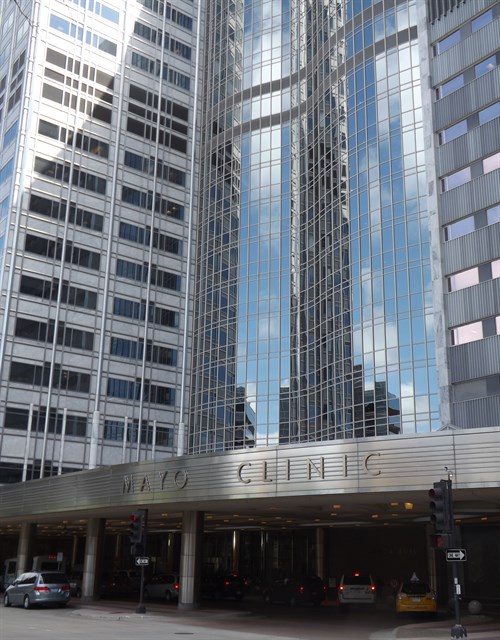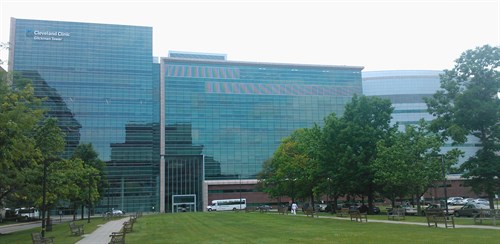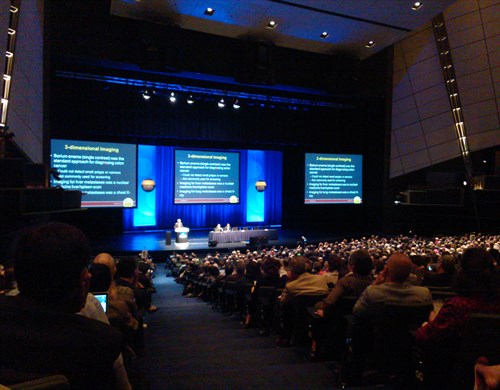Paul Sutton - Ronald Raven Travelling Fellowship 2013
Report and photos of Paul Sutton's visit to the Mayo and Cleveland Clinics
The Mayo Clinic has been consistently ranked as the leading
hospital in the United States, and is home to arguably the most
prestigious gastroenterology and GI surgery unit in the world.
Having visited the hospital in May of this year it was clear to see
why. To be upfront I believe the largest strength of the
department, and indeed the institution, is its ruthless commitment
to the integration of patient care, research and education. Indeed
this was the cornerstone upon which the hospital was founded by
Charles and William Mayo in 1889, and is evident in the three
overlapping shields on the institutional logo.
But what does this mean for patients? Yes the attending doctors
that work at the Clinic are amongst the most committed, dedicated
and able I have had the pleasure of working alongside, but the most
striking features are of the infrastructure in which they work.
Firstly they are surrounded by an incredible team of people.
Everybody who works at the Mayo Clinic are selected for being
amongst the best at what they do, including a famous restauranteur
who now runs the hospital canteen, concierges who have worked in
some of the top hotels in the world, and telephonists who undergo a
two day selection process for employment. The services that support
patient care include a 24 hour interventional radiology service,
hot reporting of frozen sections for all(!) surgical specimens in
theatre and a very knowledgeable team of nurses, nurse
practitioners and physicians' assistants who care for the
inpatients in spacious and well appointed single patient
rooms.
Whilst based in Rochester, Minnesota (a corn field in the middle
of the mid-west), the reputation of the Clinic continues to attract
some of the most challenging oncosurgical cases from around the US
and indeed the rest of the world. The buildings themselves are
vast, smart and decorated with original works of art complemented
by regular musical performances. Patients will travel for days and
stay nearby in a hotel; they are allocated their own clinic room
and will attend daily for consults and investigations. To highlight
this a young lady with recurrent rectal cancer flew from
Louisiana on Sunday, was seen by colorectal surgeons, orthopaedic
surgeons, urologists, gynaecologists, oncologists, stomatherapists
and many others, had all necessary pre-operative investigations and
underwent a pelvic exenteration with intra-operative radiotherapy 4
days later. The patient was discharged from the hospital on day 7,
remained locally in a hotel for a further 3 days and was seen again
briefly prior to leaving the state. The only disadvantage I saw to
this model of care was the difficulties it caused when, for example
in the management of benign disease, a period of watchful waiting
would have been of benefit. However the care received by patients
with advanced malignant disease was quite simply incredible.
Another key strength of the surgical department was its trauma and
emergency division, which armed with its own fleet of air
ambulances deals with an average of 4 trauma calls per day. It was
very impressive to see the systems in place for dealing with trauma
(a frightening proportion of which was paediatric), including the
commitment of the 15 strong trauma team to assessing and
stabilising patients within 10 minutes of arrival and facilitating
their transit through the department.

Whilst the surgical strategies used for the treatment of
colorectal and hepatobiliary malignancy were similar to our
practice in the UK (albeit with a greater drive for minimal access
surgery), what was apparent was a much more aggressive approach to
systemic therapy. It was interesting to have discussions with
surgeons and oncologists about the role of neoadjuvant therapies,
surgery for stage IV disease as well as how their approach to the
management of early and screen-detected rectal cancers is changing.
I was fortunate enough to observe some complex colonoscopy lists
whilst at the Clinic, including the full thickness excision of a T1
rectal tumour. A significant proportion of patients receiving
treatment were enrolled into clinical trials, mostly for novel
agents. Almost all trials were conceived from the Clinic which also
claims one of the most advanced integrated electronic patient
record systems in the world. Biobanking of tumour samples is
ubiquitous and performed by the pathology team, and laboratory
meetings highlighted the very close working of clinicians and
scientists who are striving to tease apart the nuances of tumour
biology. The hospital also boasts a live animal operating facility
for the development of innovative surgical techniques as well as a
host of other small animal and in vitro models for translational
research.
A strong commitment to education also runs through the ethos of
the department. The surgical residents and fellows work extremely
hard, with the daily routine commencing at 0600 and ending around
1900. During the week fellows are essentially on call permanently
for their service and weekends are divided between them. In return
for this they benefit from exceptional training delivered through a
mentorship model, access to a purpose built simulation and skills
centre and a rigorous programme of almost daily educational
conferences. These include grand rounds, case vignettes, morbidity
and mortality meetings, didactic sessions covering the syllabus,
journal clubs as well as presentations from the residents preparing
for their boards. The approach to education however runs much
deeper than this, with all healthcare professionals being treated
to an equally broad yet focussed educational programme. Finally the
emphasis on patient education was also apparent, with a wealth of
material provided to enhance the understanding of an already well
informed population as well as two dedicated patient education
centres within the hospital.
Having completed my visit to the Mayo Clinic I took the short
flight to Chicago to join over 30,000 other delegates for the 50th
annual meeting of the American Society of Clinical Oncology, the
theme for which was 'Science & Society'. Even having visited
McCormick Place previously the meeting was vast, although this was
well compensated for by the division of sessions into tracts and
themes and the ability to review missed sessions online after the
event. It was incredibly exciting to hear about recent advances in
oncology, one recurrent theme being the incorporation of tumour
genotype into study inclusion criteria to ensure best outcomes by
focussing on highly specific patient populations. Clearly this
allows both the opportunity to trial novel agents whilst
simultaneously allowing us to further investigate the biology of
the disease.

After the meeting I travelled to another centre of excellence for
Digestive Diseases. Founded in 1921 by four renowned physicians,
the Cleveland Clinic, Ohio now employs over 40000 people and
receives over 80000 hospital admissions per year. At the Cleveland
Clinic I had the opportunity to shadow a number of the staff
surgeons, including Dr Kalady, who I had made contact with prior to
my visit given our overlapping research interests. Dr Kalady is a
clinician scientist with an interest in response to neoadjuvant
therapy and mismatch repair genes, facilitated by his clinical role
in the Centre for Hereditary Colorectal Neoplasia - the largest in
the US and second largest in the world. The department's expertise
in cancer care is combined with its reputation as a quarternary
centre for inflammatory bowel disease as well as housing the Centre
for Functional Bowel Disorders.

My experience at the Cleveland Clinic hammered home what can be
achieved by a department dedicated to patient care, training and
both translational and clinical research. Many of the excellent
systems and processes I had witnessed at the Mayo Clinic were
apparent here. I took the opportunity to explore the decision
making surrounding the management of advanced and recurrent rectal
cancer, as well as case selection for robotic resections and
revision pouch surgery. What was particularly impressive was the
organisation of familial screening for those at risk, centred on a
one-stop-clinic co-ordinated by a dedicated nursing team. Patients
would receive endoscopic examination, uterine ultrasound and
dermatological screening as well as clinical review at a frequency
determined by both their relative risk and age. Again I visited the
endoscopy unit and inpatient wards, and attended numerous grand
rounds, conferences, scientific meetings and tumour boards. At all
times I was in awe of the commitment and professionalism on
display, and what can be achieved, be that clinically,
scientifically or educationally, by a dedicated team working in a
well-resourced environment.
It has been an absolute privilege to see the work of these two
centres of excellence, and I am confident that I have learned a
great deal which will shape my own clinical practice. Seeing busy
surgeons with 9 operating/clinic sessions a week fully and
completely integrate research and training into their practice and
simultaneously meet the demands of a complex and demanding patient
group was incredibly inspiring, as was their approach to barriers,
uncertainty and adversity. I'm grateful to Dr David Nagorney at the
Mayo Clinic and Dr Feza Remzi at the Cleveland Clinic for hosting
me, as well as Professor Graeme Poston at Aintree University
Hospital for his support and mentorship. I'd also like to express
my thanks to the British Association of Surgical Oncology for the
award of the Ronald Raven Travelling Fellowship, without which this
fellowship would not have been possible.
Paul Sutton